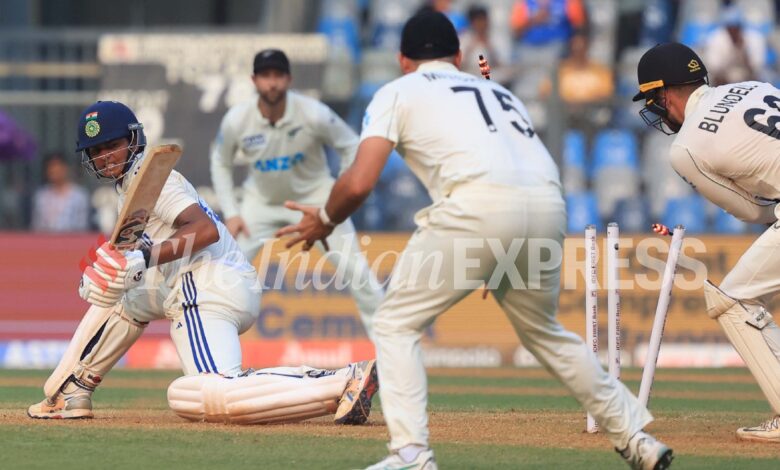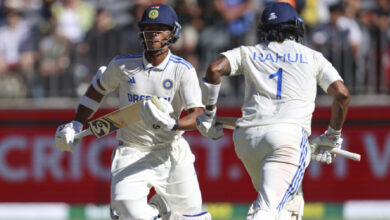IND vs NZ: Another Indian batting collapse after Ravindra Jadeja’s retro show | Cricket News

Arms aloft and spread, eyes shut skywards, Ravindra Jadeja soaked in the sunlight and spotlight at the Wankhede. He claimed his first five-for of this series, his second in 26 innings, busted the stoic resance of New Zealand’s batsmen as well as the suspicions about his waning prowess. There was something more about him on Friday, him rediscovering the joy of bowling, him time-travelling to the spunky days of youth, and him lurking like an immovable reality.His 21-1-62-5 stalled New Zealand’s progress at 235, a robust though not indomitable total on a surface that is already throwing up a few tricks, but could transform into a full-blown evil turner in a few sessions. This was the brand of surface where Jadeja once scythed through attacks, a surface with bounce, adequate pace and sharp turn. But somewhere in his cycle of evolution, he had lost the art of skinning batting line-ups on helpful surfaces.
However, India couldn’t take advantage of Jadeja’s stunning bowling display. the end of play, the hosts were in the middle of another batting collapse.
Bowling brilliance ✨
Recap Ravindra Jadeja’s skilful five-wicket haul in Mumbai 🎥🔽 #TeamIndia | #INDvNZ | @IDFCFIRSTBank | @imjadeja https://t.co/gQIWktNswi
— BCCI (@BCCI) November 1, 2024
Like so often in the series, the Indians had failed to adjust to the home conditions. New Zealand’s modest total of 235 was looking menacing. India were 86/4 with Shubman Gill (31) and Rishabh Pant (1) on crease. India’s batting mainstay Yashasvi Jaiswal (30), Rohit Sharma (7) and Virat Kohli (4) were back in the dressing room. And so was the night watchman Mohammad Siraj.
He became more condition-proof, more layered and subtler, but Jadeja lost something that made Jadeja. He lost the art of taking wickets on excessively helpful conditions. On pitches that needed the Jadeja of the old, he couldn’t reproduce his quick-kill avatar.
At Wankhede, he put on a retro show. He bowled wicket-to-wicket for most of his spell. Most balls landed in line with the stumps, often the off-pole. If not, it spun towards the stumps. The mode of dismissals capture the story—three were bowled, one was leg before the wicket. The other one landed on the off-stump and turned away a wee bit to take the outside edge. The line alone congested the batsmen. He bled just four fours, of those only one was from a short ball. One was off the edge, the other two a sweep and reverse sweep. His precision stifled them more than the heat. He eschewed his mid-career impulse to give the ball more air and hang-time. The slower balls of his coerced sharp turn, but those were largely set-up balls, the tease before the trick.
The wrecker ball was the fast, flat one on the stumps. His simple you-miss-I-hit strategy. The Jadeja prototype, the ruthless efficiency of this variety accounting for most of his early scalps. All five of his wickets clocked 90 kph-plus. The quickest one—clocking 95.7 kph—whizzed through the shocked defences of Glenn Phillips.
The previous balls too were full and fairly quick, 90kph or thereabouts, which lulled the New Zealander to a false sense of security. Then he suckered him into a lazy front-foot defence with a yawning creek between his bat and pad. The wicket of Phillips, the score at 187/5, exposed an uncommonly long lower-order to a surface gnashing its fangs. He rapidly got Ish Sodhi (90 kph) and Matt Henry (90.6) to fashion a turnaround.
Stumps on the opening day of the Third Test in Mumbai.#TeamIndia move to 86/4 in the 1st innings, trail 149 runs.
See you tomorrow for Day 2 action
Scorecard – https://t.co/KNIvTEyxU7#INDvNZ | @IDFCFIRSTBank pic.twitter.com/ppQj8ZBGzz
— BCCI (@BCCI) November 1, 2024
It began with Jadeja too. Minutes after the first drinks break, just when Will Young and Daryll Mitchell were terrified to drag the match beyond India’s reach, he produced an edge trimmer (93.7 kph) to eject Young. The latter’s discretion outside the off-stump was immaculate. But Jadeja, unlike Ravi Ashwin, made him play at most balls. A couple of times, the edgy interventions of the bat saved him at the last moment. So he committed to a ball that landed on off-stump, which spat away marginally. It took his edge en route.
Had it turned a centimetre more, the ball would have escaped the ball. But this was knit to perfection. He harnessed the bounce too, imparting more over-spin, letting the ball rip off his hands and bounce awkwardly at them. The wicket energised him. He laid the trap for Tom Blundell even before he took his guard. Two slower full length balls on off-stumps, two dissatisfied shrugs as Blundell comfortably defended those, he flung in a fuller, faster ball on middle stump. Blundell pushed forward, he was not to the pitch of the ball. Then it ragged across him to hit the stump. This was the only wicket that Jadeja owed to the side-spinning ball.
Not that he couldn’t or didn’t turn the ball, but he realised the ball that turned only provided theatrical flourishes. Often, batsmen negotiated them playing inside the line, not committing to the balls and taking the bottom hand off. Just before lunch, he unearthed a ripper that screamed past Young, forcing acrobatics from Rishabh Pant to deny es. But it was not serving the purpose of getting the wickets. Ravi Ashwin too would realise this; Washington Sundar had already illustrated the virtues of the ones that didn’t turn on a turner. Both Tom Latham and Rachin Ravindra were dispatched up the stairways of Wankhede thus.
So he returned to the values that once made him—unremitting precision, supreme control, the wits to res the lure of the turn, and the know-how to trap batsmen with simple and subtler than grand tricks. It was not the most spectacular spell he had bowled, but one that would fill him with immense joy. And a five-for for old times’ sake.







